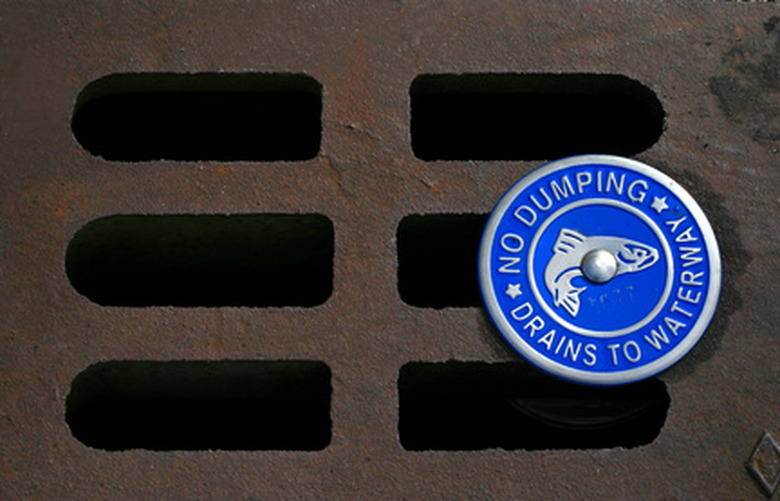How Do I Clean Up An Outside Sewage Spill?
Outdoor sewage spills pose a serious threat to the environment and people, due to the harmful pathogens they contain. You should take immediate action in the event of an outdoor sewage leak to minimize the damage. Protect yourself and others, contain the spill from spreading, clean the spill and disinfect the area as much as possible, while you wait for professional help.
Protect Yourself
Protect Yourself
Protect yourself and others from coming in contact with the sewage. Keep pets and children away. Wear protective clothing before dealing with the sewage spill to protect yourself against harmful bacteria, viruses and parasites. The Workers Health Centre in Australia warns "microbes in raw sewage can enter the body via the nose, mouth, open wounds or by inhalation of aerosols or dusts." Tetanus, Hepatitis A, E. Coli and parasites are among the microbes possibly present in raw sewage.
The ideal way to protect yourself from contamination is to wear rubber gloves, rubber boots, a waterproof bodysuit, goggles and a mask. Chances are you do not have all these protective items on hand, so do your best with what you have to cover yourself. Things like sunglasses, jeans, a long sleeved jacket or a rain jacket, gardening gloves and waterproof hiking boots offer some protection. Cut head and armholes in a large plastic trash bag and wear the bag over your clothing for a little extra protection.
Discard all protective wear items after you finish cleaning the sewage spill and take a shower.
Contain the Spill
Contain the Spill
Contain the sewage spill to prevent it from spreading and contaminating a larger area. Most importantly, stop the spill from entering storm drains and nearby natural water sources. Turn off the main water supply, if possible, to prevent more water from entering the sewer. Clear out debris that is causing the sewage spill, if the cause is evident. Place sandbags, dirt or plastic tarps around the perimeter of the spill to stop the sewage from spreading.
Clean the Spill
Clean the Spill
Clean small sewage spills–less than 10 gallons–using either garden lime or a wet/dry shop vac. Call an environmental waste cleanup company, septic tank company or your city health department to clean up large sewage spills.
Liberally sprinkle garden lime over the spill to absorb the sewage. Allow the lime to dry overnight. Once the lime is dry, scoop it up using a rake or shovel, and throw the sewage-contaminated lime in a trash bag. Throw the trash bag and shovel or rake in a trash receptacle. Wash the remnants of dried lime away from the ground by using a garden hose.
If you do not have garden lime, use a wet/dry shop vac to suck up a small sewage spill. Throw the shop vac and sewage contents contained within, in a trash receptacle.
Disinfect
Disinfect
Disinfect concrete and other man-made areas with bleach. The Department of Environmental Conservation in Alaska recommends using 3/4 cup Clorox bleach to one gallon of water. Scrub man-made surfaces with the bleach mixture and a brush broom or mop, being careful to not allow the bleach to enter storm drains or contaminate natural bodies of water.
Do not use bleach on grass, dirt or other natural surfaces. Instead, call an environmental waste clean-up company, septic tank company or your city health department and have them come out and disinfect the area.
Report
Report
Hire a professional plumber to repair the problem that caused the sewage spill. Report the sewage spill to an environmental waste clean-up company or your city health department to have the area evaluated for severity of environmental contamination and further cleaned if necessary.
